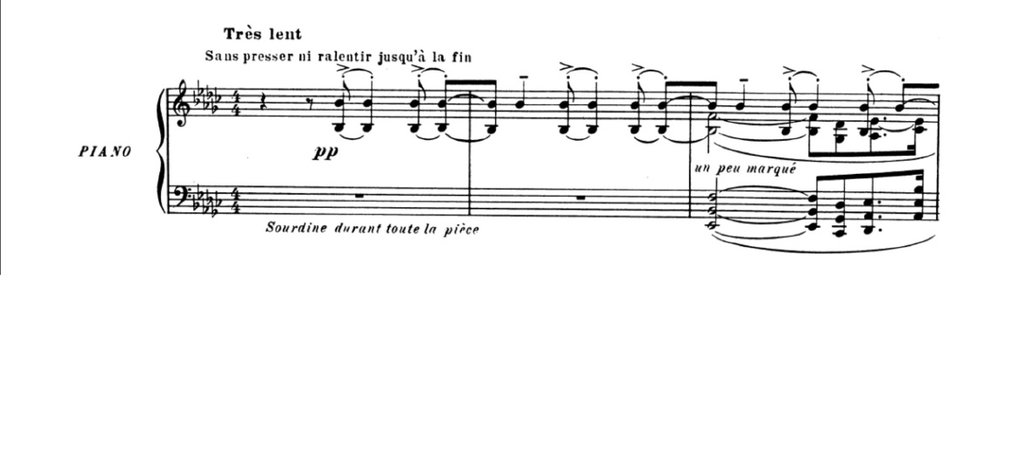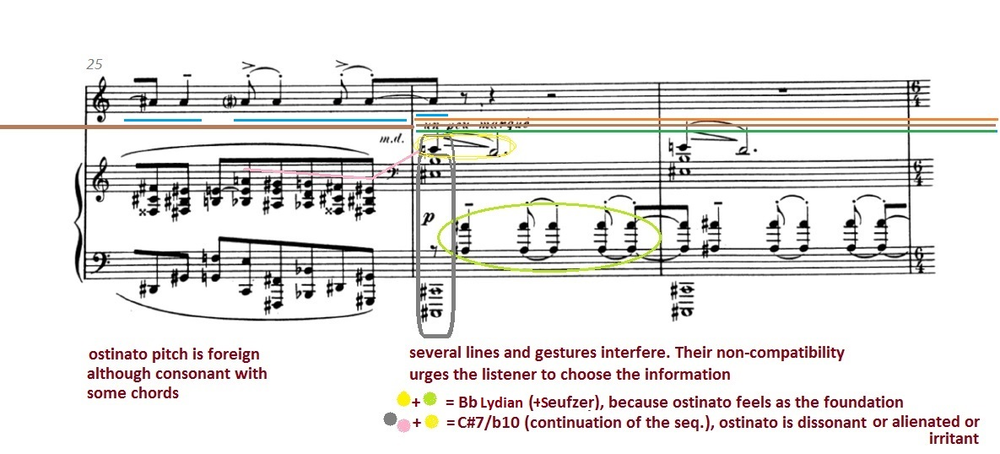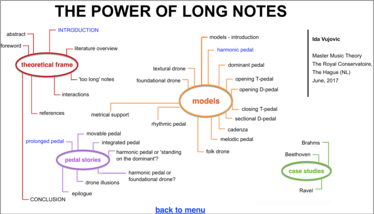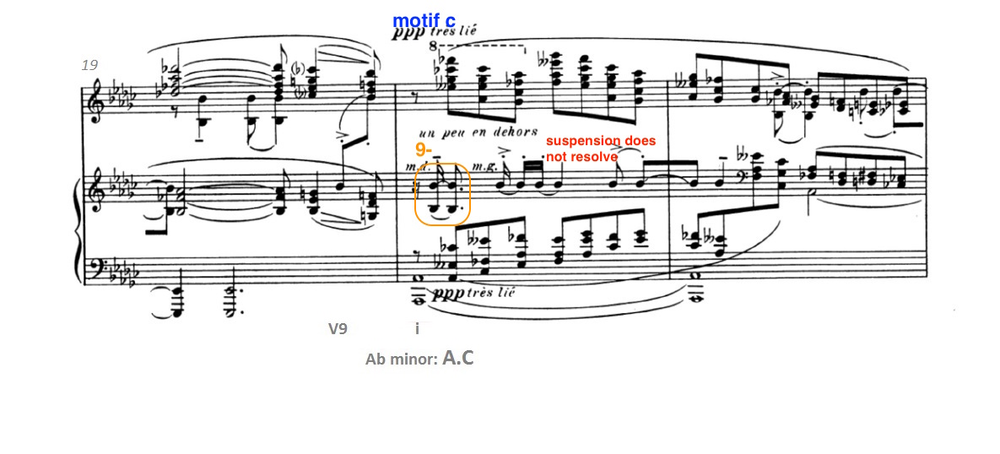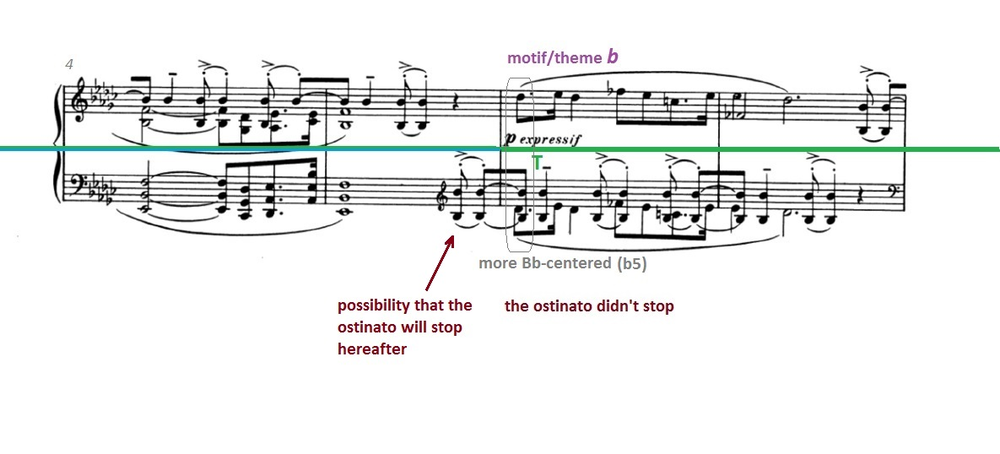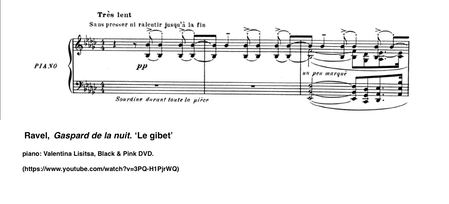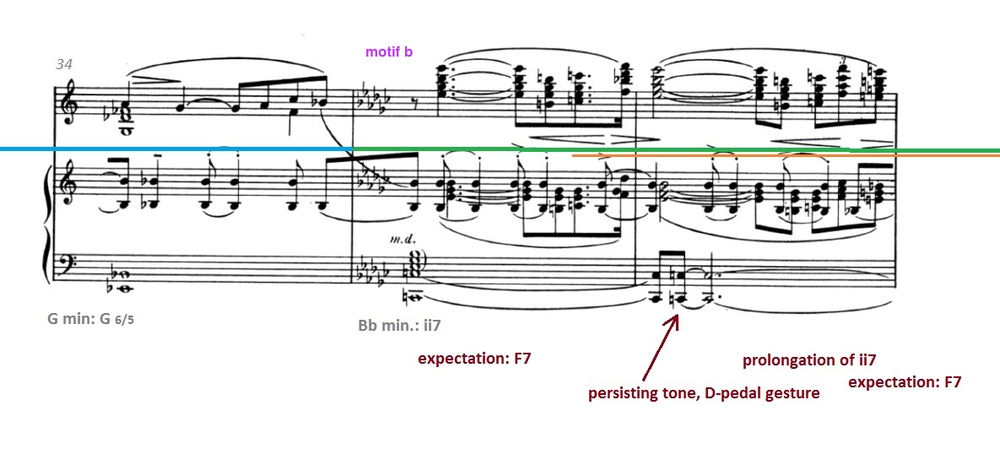Case Study: Ravel, Gaspard de la nuit, 'Le Gibet'
Pedal-ostinato Bb sounds throughout the piece. Not in all the bars is it exactly the same rhythmic pattern (due to changes of meter and occasional other purposes) but the listener is aware of its presence. Its registral position is in the middle octave; in later parts of the piece it appears also as a long pedal-tone in low register. Although it is always the same pitch, sometimes we are aware of its tonal function and sometimes not. Its ‘meaning’ is changing from tonal to formal, from formal to sonorous, and back.
Written on the text of A. Bertrand, “it is a musical landscape of the singular, breath-taking image of a lonely corpse reddened by the setting sun” (Eccles, 2004). In the original poem the not-yet-dead man is hanging on a gibbet in a desert. A witness of this sight hears steady sounds and contemplates on where these sounds could come from (cricket, fly, scarab beetle?). At the end of the poem the hanging man is dead and the witness realizes that the constant sound is the tolling of the bells, somewhere in the distance.
Being put in programmatic context, we could speculate that the ostinato theme (Fig. 1) presents the tolling bells. It is the sound that connects all the other images, as it is creating a firm thread leading us through the landscape. This idea will prove fruitful in the sections where the tonal meaning of Bb is temporary not so clear.
Figure 1
The sonorous language of the piece is based on quintal chords, seventh- and ninth-chords, with influences of jazz harmonies. Instead of major or minor keys, Ravel uses a number of modes, perhaps preferring Phrygian and Aeolian. More than that, he doesn’t restrict tone collection to traditional modes exclusively: through various alterations the modal language becomes even richer. Raised fourth and flat fifth appear very often in minor-third modes. However, the modality is mixed with tonality, through occasional use of functional chord progressions and other tonal gestures. The very interesting tone-collections and their gradual modifications and modulations in this piece are out of scope of this essay. Therefor I have chosen for simplification and reduction of most of the tone collections with salient tonic to 1) those with ‘major flavor’ (having a M3), and 2) those with ‘minor flavor’ (having a m3). In the analysis, the latter with be indicated with the capital letter followed by a lowercase ‘m’ (e.g Ebm). ‘Tonal-functional ears’ of the listener will occasionally recognize tonal gestures even when the tone collection features uncommon alterations. For example, in mm.6-7, one could feel a kind of a minor key (despite the flat fifth). The tone-collection in mm.6-7 is actually a pentachord of diminished scale, but in case it is not recognized as such, the chance is big that it will be perceptively categorized as a variant of minor (the full, annotated score is presented in the film at the end of this essay). As will be clear at the end of this analysis, one of the factors that strongly influence (aural) determining of the key-center is the ostinato tone.
It comes as no surprise that functional position of pedal tone is not always clear in such tonal systems. The ‘bi-tonal feel’ throughout the first phrase (from m.3) teaches the listener that harmonic relations will not always be straight-forward. The beginning (Fig.1) promotes two modes as home-keys: Bb Phrygian and Eb Aeolian.
The first Très lent reiterations of Bb note pave the ground for the ‘home-space’. The appearance of the first chord brings in uncertainty, as it opens the space for two possibilities: the particular tone-collection (Eb-Bb-F) frames two (tonic?) chords, Eb and Bb. The tone collection facilitates both modes. Harmonic motion (rather than progression) is based on parallel quintal chords, which is not contributing to the establishment of tonal hierarchy. Another non-directive factor is the absence of leading tone (first leading tone - of yet another mode - is appearing in m.10). [1] The factor that influences not only the perception of the mode, but also the perception of various musical events in this piece, is the interaction of multiple perceptible layers. As will be clear also later in this text, melodic and harmonic layers are often in a conflicting or even competitive relation. In the opening of Le Gibet, there are (at least) three salient threads: the ostinato, the chord progression, and the melody (F - Db - Eb - Cb - F). Interestingly, the melodic layer is cooperative with both ostinato layer (suggesting the Bb-center), and chordal layer (suggesting Eb-center). The listeners less used to extended harmonies would probably (perceptively) choose the more simple relation - the one resulting in Bb Phrygian interpretation.
Although there are arguments for both Bb and Eb as the tonal center, for the current topic it is exactly this ambiguousness of the mode that matters most. Put in the programmatic context, we could speculate that this uncertainty refers to the uncertainty of the observer in the Bertrand’s poem: the observer does not know what that constant sound actually is.
The (tonal) function of Bb could be defined as the point of reference.
Reiterating a single pitch in the opening of a piece could be understood as fanfare pedal. If that would be the case in Le Gibet, the first bass note, Eb, would be heard as the tonic, and fanfare-pattern would be fully realized. However, not every listener will have this aural interpretation. Different than the opening of Chopin’s Grande Valse Brillante (discussed in the chapter on fanfare model), the opening of Le Gibet is not necessarily recognized as an ‘announcing’ gesture. The opening of Ravel’s piece lacks metrical saliency, in order to be perceived as a pattern. The pattern does exist (albeit misleading for the determining of the meter), but the introduction is not long enough to facilitate its discovery. In case the listener does assume that the length of the pattern is equal to four beats, and that it is being repeated in m.2, she will certainly be surprised to hear the ‘actual beginning’ before the pattern is rounded. In either case, there is no acceleration involved, which suggests a stable nature of the ostinato, a foundation, rather than ‘the other’.[2]
The listener does not expect the ostinato to stop and I believe that this is relevant for its ‘working’ in the perception.[3] This explains the (at least possible) perception of Bb as a tonal center in complex tonal setting such as around m.26, which will be discussed shortly. What influences this non-expectation of change (rather than an expectation of staying unchanged)? One of the main actors, I believe, are the form, and the acquaintance with pedal/drone models. From the initiation of the first phrase it is clear that this pedal does not have high harmonic energy (cooperative interaction of, among others, the key-ambiguity, sonorous consonance of the pedal, the position of the pedal-pitch in higher register). This pedal-ostinato does not require any particular continuation, and probably have another function or position in this piece. After registering that the ostinato hasn’t stopped after the introduction, the listener assumes the possibility that it will function as an agent of formal differentiation. This assumption increases the probability that the pedal will stop at the beginning of the next section. When it continues sounding after motif b (m.6) has lounged, the expectation shifts to the next hierarchical level (the first two motifs become grouped).[4]
[1] Analytical strategies could emphasize the non-logic of building the whole piece around the dominant. On the other hand, the power of the first bass note could establish its pitch as the tonal/modal center. Listeners used to modal hearing of flamenco music would not necessarily take the first Eb as the tonic. Taking into account Ravel’s relation to Spanish music, Bb Phrygian would not be a strange interpretation. However, my own listening experience has proved that theoretical considerations do not always reflect the way this piece is perceived. The factor that strongly influences the listening is the focus of attention. The reader is encouraged to listen to Le Gibet focusing on the pedal ostinato, and to compare that impression with the impression after focusing to the bass line and the chords.
[2] It is possible that the reader has a different aural experience, due to the differences in the aural context in which the music events of Le Gibet are perceived (e.g. musical background or particular focus). In that case, I invite the reader to take a slightly different focus, and listen to this piece from the perspective suggested in this essay.
[3] In some aspects, this ostinato reminds us of the discussed rhythmic pedal in the accompanying voices model. Common elements are: overall presence, (almost) constant rhythmic ostinato, registral position in the upper part of the texture. However, it is lacking a steady pulsation, so characteristic of the model. Next to this, it is harmonically not integrated in the most chords of the piece.
[4] The bar numbers are indicated in case the reader prefers reading with the score at hand. The link to the full score is (be sure to open it in new window):
http://imslp.nl/imglnks/usimg/3/3b/IMSLP00600-Ravel_-_Gaspard_de_la_Nuit.pdf.
Otherwise, proceed without the score, and just follow the story in a more general way. As I have already mentioned, the annotated score will be shown in the movie at the end of the essay.
Figure 4
Grouping of the stimuli (notes, patterns) around m.26 results in perceiving a polyphonic superposition of far-related musical gestures. In m.25 (Fig.4) we can observe four lines that arrive in m.26: the ostinato A# (Bb), the falling 5th harmonic sequence (with one alteration: F# instead of F), and the chromatic line consisting of the notes that are extending the seventh-chords. Arriving in m.25, the harmonic end is the C#7/b9/b10/13 chord.[6] Listeners who recognize this sonority could be surprised by the events in m.28. This chord belongs to the Klangfeld of octatonic scale. The following theme (from m.30) is also made from the same tone collection (although the choice of notes could suggest another type of mode). Listeners not acquainted with either this sound field or the extended chords could feel challenged to understand the meaning of the event in m.26. In m.25 the ostinato tone was a chord tone in almost all of the harmonies, and the harmonic rhythm was fast. Now in m.26 the harmonic rhythm has come to a hold[7] and the A# could feel to be too exaggerated for a 13th of a chord. The third element in m.25 is the blue-marked melodic figure, a Seufzer-figure, that could also be felt as not belonging to the chord. E is the end of the chromatic line and could be put in harmonic context, but in that case D# and not D is a logical consequent. The four elements in m.25 are difficult to aurally understand as a coherent whole. Understanding E-D as a Seufzer-figure asks for a harmonic context different from the one created by the sequence. Understanding E as a b10 in C#7 chord asks for either D# or E# as the continuation. In the former case, there would be a strong expectation of F# chord as a consequent. And then, there is this firm ostinato pitch, that is not related to any of the other lines. Or is it?
[5] Psychology teaches us that the brains favor some types of representation over others. Huron (2006:122) explains that “the preferences are for (1) lower-order relationships, (2) neighboring over distant relationships, (3) lower-derivative states, and (4) event-related binding.” At the moment the ostinato tone in Le Gibet is perceived as a 9-8 suspension, the relation between its pitch and the harmonic movement at the moment is closer, and of lower-order (meaning between a small number of elements) than the relationships that its pitch has with other musical events.
[6] This is the tone collection of the entire m.26. Differentiating the roles of E and D (melodic motif), could result in understanding E as appoggiatura.
[7] In the most performances the final chord (C#) is a bit delayed, to prepare for the closure (mm.26-27). Without the delay (not scored), the music would feel as suddenly held back, and would cause a surprise-tension. In this case, there are other tensions at work.
[8] The theory of exposure effect claims that the stimuli that have occurred most often, tend to be liked more than others. Huron’s response to this theory is an alternative, the concept prediction effect. According to him, it is not the frequency of occurrence, but the predictability that causes the effect of preference. (Huron, 2006: 131-138). In the case of Bb ostinato, I will not try to persuade the reader that this pitch will be felt as ‘more pleasing’, but according to both theories there will be a different attitude towards this pitch than towards the others. In case the combination of stimuli is felt as difficult to understand, the listener could intuitively cling to the ostinato pitch. The Bb could be taken as preferred reference point. Nevertheless, this is only a possibility. The listeners who are strongly attracted to harmony will, in the same way, experience the positive prediction effect related to the target chord C#, which will thereby become the reference point.
[9] In the chapter ‘Too-long notes’ I have refered to Meyer, and proposed seeing such situations as cases in which mental synthesis does not lead to a clear image of the musical assemblage (or simply, to an understanding of what is going on), and react with rejection of the stimulus that cannot be understood. See also the Case Study: Brahms (on A German Requiem).
Figure 3
In the second section (from m.20), the Bb ostinato is more dissonant, but at the same time more stable. The stability is now not felt as a function of harmonic or tonal position, but rather as the most fundamental belief. We have learned that the pedal goes on, no matter what. The fact that Bb is there, becomes more important than its possible other functions. The suspension in m.20 is not resolved, the necessity to resolve (the tonal dissonance) is abandoned instead. In m.23 the Bb becomes a soothing m3 to (at that moment) the tonic chord, which also changes soon. Interestingly, when its function is not clear any more (m.23), it seems not so important if it is consonant or dissonant with the chords in the progression; it is alienated and that is its primary relation to the other events.
In this section the harmonic progression is not clearly directed: in m.21 the listener is not sure about the tonal center or the harmonic goal. She hears harmonies (sonorities), and Bb is dissonant with them. The falling fifth sequence (m.21 and m.22) is recognized as such but Bb is not immediately understood in that context. The ostinato-tone starts having own life. In some parts of Le Gibet this life seems not to interact with other musical agents. The ear cannot always find a common denominator, and so the ostinato and the other perceived elements could be felt to just co-exist, without effect on each other. According to the low of Pränganz, the mind will project the best possible interpretation on the basis of all the perceived stimuli. In case no interpretation is found for all the elements together, in case they are being in a competitive relation (a ‘rabbit-or-duck problem’ where only one can win), the mind will be forced to choose. Let us examine closer the events around m.26:
Figure 2
The prominent bass-pedal in m.12 bares a hint of a closing unit (I will return to this), which has implications for the perceived probability that the ostinato will stop when the harmonic bass-pedal is resolved. It does not happen, the resolution is weak, the section is not yet closed, there is another harmonic bass-pedal on Eb, and the final possibility to terminate ostinato in m.20. Indeed, in m.20 the ostinato pitch gets for the very first time a different identity, loaded with energy. The resolution of the dominant chord (in Ab minor) is this time at least for a moment not weakened by any conflicting interaction, even the ostinato is for a short moment silent. Next moment, the Bb is very clearly heard as the 9-8 suspension. This particular resolution is understood as a musical gesture (most performers, including Ravel himself, make a short ritenuto to communicate it to the audience), and it seems that this gesture has strong implications: the section is finally closed, the Bb will most certainly resolve and terminate. This is a first-level expectation, the most direct, local necessity.[5] The implication is very strong, and so the expectation-tension that it incites. However, the resolution is not granted, causing denial-tension. The ostinato continues, and at this point it is clear that it will not stop. The ostinato is there to exist. This new expectation is not denied.
listen to the piece with annotated score
the movie will open in new window
Figure 6
Let us return for a moment to m.12 and the initiation of the long Bb tone in the bass. This tone is extremely important as it makes a huge impact on the listener. In the harmonic language with much freedom and uncertainties, this is the first moment when the key is perfectly clear (at least, that is what the listener feels at that moment). Even though Bb pitch is present without break from the very first bar, it is only in m.12 that this new realization of Bb really acts as a strong harmonic-actor. It certainly has to do with the register (strong harmonic implications of the bass). However, low register has sounded also from the beginning. Let me repeat, what is noticed is the gesture of pedal: splitting of the harmony in two layers, the bass tone sustained. Of course, this was made possible by the other notes: had they been on other pitches, the Bb was perhaps not possible to feel as the dominant. And this is a nice example of cooperative interaction between all the pitches and the possibilities provided by the style, for the goal of establishing the key. It is also an example of the interaction between the rich sonority of Ravel’s harmonies and a gesture from a much stricter harmonic language; the pedal model is retrieved from the memory (knowledge) of the listener.
The purpose of this bass-pedal was perhaps not at all related to tonal clarity; it could be related to creating excitement. This is certainly its important effect. When the bass-note Bb establishes itself as the dominant pedal, it incites expectation-tension; at the moment the listener is anticipating on the resolution and is experiencing tension related to this expectation. This excitement is to a certain extent different than with typical dominant pedals in Baroque or Classical music. While there, pedal is perhaps the most ‘deviating’ element, in Ravel’s piece pedal is providing the tonal orientation. As such, it brings also relief, and the excitement of the completion of the process.
Another, quite similarly looking bass-pedal did not have the same supportive co-actors, for realizing the same power. In m.35, while still being in G minor (with flat fifth at the moment), simultaneous onset of the bass-pedal on C, and the Eb minor triad forms C half-diminished seventh chord. This chord sets the new hierarchies, and re-establishes Bb in the position of the tonal center (m3 modus). This is the consequence of the expectancy. It happens only if C-chord points at F as its consequent. Expecting the ii-V-I progression upon hearing the C-chord directly establishes the key. Implicitly thus, the listener expects the F major chord. If the listener recognizes the motif a, she will understand the possibility that the chord will sound for three bars before change. However, without changing the tone collection, the chord progression neutralizes the directedness of C-chord, which thereby loses its power as sound term, leaving the pedal tone C to sound as a remnant (m.38). In the context of Bb mode, C is not a very strong (stable) pitch. Being in the bass so long is also not a very directional gesture. Perhaps this is the reason that it could so easily be neutralized by the chord succession above it. In m.40 the listener returns retroactively towards the C half-diminished chord - at that moment already ‘resolved’ to Bb diminished triad that feels as the tonic - as the result of the recognized plagal relation.
The opening of theme d (which is built on the closing material of the previous theme, and is distinguished from it by formal differentiation created by the abrupt change of the melodic register and the texture in m.28) is felt in a Bb-centered mode (with m3 and aug4). The pitches A and G (appearing in m.29) are not necessarily in conflict with this tone center (Fig. 5). Nevertheless, it is these pitches that redirect the tonal attraction towards D. Of course, this is also visible in the score: the A7 chord appears as block-chord under the melody. Two of them work as a strong sound term (meaning they arouse strong expectations for a particular consequent event). This power overrules the existing power of Bb, which is, for a moment, even pushed into the background (made suspension to A, then silenced). M.30 does not bring the expected resolution but the D-centered mode remains a possibility. The ostinato however loses its clear function. Once more, it has to compete with other actors for the role.
Figure 7
The long C bass-pedal (or just a long note?) has influenced the perception of the Bb ostinato. Although Bb is now the tonic (from m.35), it does not ‘work’ as a tonic pedal. It does not provide the home-feeling, but rather a sense of dissonance. In m.37, when C pedal loses its energy as a pedal-tone, and the feeling for the tone-center has changed, Bb ostinato gets the space to be at least consonant. In the cadence in m.40, the ostinato pattern deviates for a moment, which is not even noticed, covered by the last and longest bass-pedal in Le Gibet, the tonic pedal of the last section.[10] Retroactively, in a way, due to its position in the structure, the C-pedal could be interpreted as a variant of the dominant pedal before the end (of a piece or of a development section). The last section (from m.42) is a hybrid of coda and recapitulation. The former because of its structural position (after the last cadence) and its tonic-prolongation. The latter because of its tonal rounding of the important thematic material. The ambiguous key of mm.10-11 is in m.42 ‘corrected’ with the tonic bass-pedal. The succession of more or less parallel chords from m.20 is now varied and realized in the Bb-centered mode (mm.43-44). The melodic figure from m.26 could be recognized in the series of similar figures in the middle voice of mm.44-50. The last variant, Db-Bb, clearly the tonic, appears above the unchanged material of the first theme (a), which was in m.3 felt as bi-tonal.[11]
In a conclusion, the pedal tone Bb (realized through omnipresent pedal-ostinato figure and the long notes in the bass in some bars) has in most bars tonal (harmonic) meaning, being the tonic, the dominant, the second scale degree. In some sections its harmonic meaning ceases and it remains an ostinato figure with sonorous but not harmonic properties. Throughout the piece it binds the motifs into a whole, providing a common thread. In this sense it can be a formal element, thus having a formal meaning. This last is by no means only an analytical conclusion. As the piece consists of a number of recurring motifs – which is sufficient for a formal unity – the pedal tone is theoretically not a necessary factor for this purpose. It is much more an aural thread that provides the stability and unity of the piece. Returning to the programmatic dimension, it provides the sense of suspense, a static atmosphere where all the coming thoughts cease, and one returns to just being there – finally ceasing even to be.
[10] While some listeners will at this moment feel that the bass-pedal Bb is the dominant, I hope that I have given enough arguments to understand the possibility of hearing it as the tonic - as I do.
[11] This interpretation is based on the context (perceptively) defined by the long bass note that is perceived as non-conflicting, and the melodic figure that is transformed until reaching its final, consonant form as Bb-Db. However, the last section features also harmonic elements that suggest Eb as the tonal center. It is quite certain that this fact will be perceived as most important by some other listeners. The aim of this essay is to show how this ambiguity comes to existence, and how it influences the perception of other musical events.
Figure 5
Another example of competitive interactions is in m.10. It is related to the tonal context. While the tone collection is referring to Ab minor, sticking to the pedal tone (that was the tonic in m.9), blurs the feeling of a tonal center, now localizing it on both Ab and Bb.
The first time that the key/mode is perfectly clear is in m.12, when another prolonged Bb sounds in the bass. The listener immediately recognizes the dominant-pedal, as a harmonic gesture, which firmly appoints Eb to be the key-center. This belief is not undermined by the other musical events that follow (despite many alterations), and it is finally confirmed in m.15. The (felt) authentic cadence should yet have to resolve the suspension 4-3. Interestingly again, the ‘tonic’ resolution in m.15 is again the same type of chord as in m.3 (combining Eb and Ab regions).
listen to the piece with annotated score
the movie will open in new window
